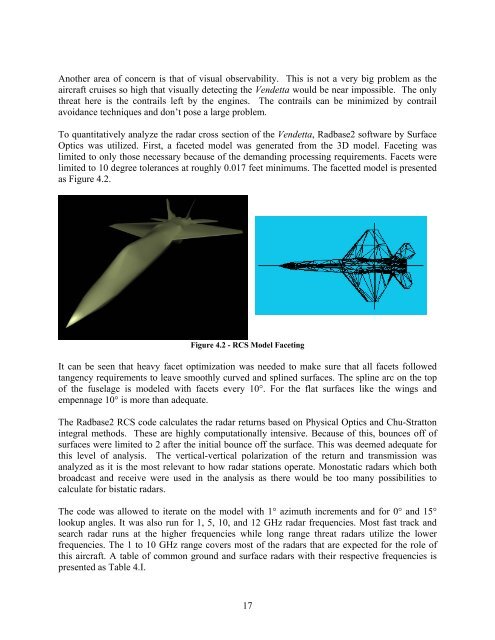SAWE Report - Cal Poly San Luis Obispo
SAWE Report - Cal Poly San Luis Obispo
SAWE Report - Cal Poly San Luis Obispo
Create successful ePaper yourself
Turn your PDF publications into a flip-book with our unique Google optimized e-Paper software.
Another area of concern is that of visual observability. This is not a very big problem as the<br />
aircraft cruises so high that visually detecting the Vendetta would be near impossible. The only<br />
threat here is the contrails left by the engines. The contrails can be minimized by contrail<br />
avoidance techniques and don’t pose a large problem.<br />
To quantitatively analyze the radar cross section of the Vendetta, Radbase2 software by Surface<br />
Optics was utilized. First, a faceted model was generated from the 3D model. Faceting was<br />
limited to only those necessary because of the demanding processing requirements. Facets were<br />
limited to 10 degree tolerances at roughly 0.017 feet minimums. The facetted model is presented<br />
as Figure 4.2.<br />
Figure 4.2 - RCS Model Faceting<br />
It can be seen that heavy facet optimization was needed to make sure that all facets followed<br />
tangency requirements to leave smoothly curved and splined surfaces. The spline arc on the top<br />
of the fuselage is modeled with facets every 10°. For the flat surfaces like the wings and<br />
empennage 10° is more than adequate.<br />
The Radbase2 RCS code calculates the radar returns based on Physical Optics and Chu-Stratton<br />
integral methods. These are highly computationally intensive. Because of this, bounces off of<br />
surfaces were limited to 2 after the initial bounce off the surface. This was deemed adequate for<br />
this level of analysis. The vertical-vertical polarization of the return and transmission was<br />
analyzed as it is the most relevant to how radar stations operate. Monostatic radars which both<br />
broadcast and receive were used in the analysis as there would be too many possibilities to<br />
calculate for bistatic radars.<br />
The code was allowed to iterate on the model with 1° azimuth increments and for 0° and 15°<br />
lookup angles. It was also run for 1, 5, 10, and 12 GHz radar frequencies. Most fast track and<br />
search radar runs at the higher frequencies while long range threat radars utilize the lower<br />
frequencies. The 1 to 10 GHz range covers most of the radars that are expected for the role of<br />
this aircraft. A table of common ground and surface radars with their respective frequencies is<br />
presented as Table 4.I.<br />
17













